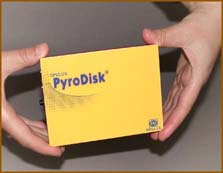|
|||||

21 CFR Part 11 Compliant Temperature & Calibration System for Microplate ReadersBela Jancsik, Gabor Klivenyi, Robert Bakos, Anita Istokovics,
Gabor Danyi, Laszlo Bernatsky, Andras Fabula, and Zoltan Lukacs AbstractWe have developed an ultra-thin - 4mm thick - wireless data logger for temperature calibration & temperature verification for controlled temperature operations in microplate readers. The device, named PyroDisk, can be utilized in various ways to evaluate temperature accuracy & temperature uniformity of the incubating chamber and of the intra-well and inter-well characteristics of the microplates relative to the incubators' temperatures. The functionality of the device has been extended by the insertion of replaceable & modular calibrated photometric filters for wavelength accuracy or photometric accuracy calibrations. Additional inserts can be used for luminometry or fluorescence calibrations. The calibrator system has been integrated to 21 CFR Part 11 software with natural language SQL for SQC & SPC modeling. The measured results were evaluated statistically and the temperature gradient was mapped graphically. Various methods were tested for temperature compensation, gradient reduction, and improved heat transfer. Experiments were conducted for the evaluation of temperature efficacy relative to standard microplates, glass microplates, silver coated microplates, & temperature compensator implants. IntroductionTemperature calibration is a core requirement in
manufacturing processes, environmental monitoring, and analytical chemistry. In
fact, temperature is a critical control point in kinetic measurements. In spite
of this, incubating-kinetic microplate photometers, which support photometric
calibrations, do not provide meaningful solution for temperature calibration or
temperature verification of the readers. Why? Let us explore some of the
challenges, that must be "tackled" in the creation of a
"meaningful" temperature calibrator: Materials and MethodsEquipment Material Calibration & Evaluation Sequence Experimental Design (Fig. Design Qualification)Objectives In the present work the following parameters of the equipment were determined: Heat transfer efficiency: The parameter was characterized by the average of the temperature values measured by the sensors at the end of the 80 minute runs. Accuracy: Temperature accuracy of the microplate photometer used in our experiment is defined by the difference of the temperature determined by the PyroDisk (taken as the true value) and the temperature readout (temperature set) of the the microplate photometer. Variability: the maximum of the difference between any two temperature values measured by different sensors at the same time. For the determination of the two latter parameters, the last 5 minutes of the 80-minute measurement runs were evaluated. Design of Experiments
Results
ConclusionFrom the existing experiments we have been able to conclude the following: |
